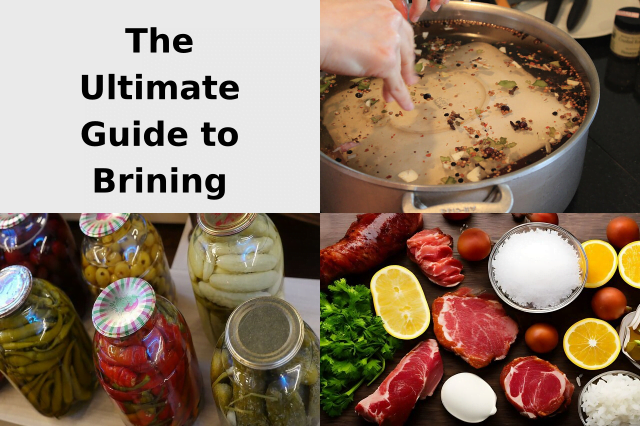Brining 101: A Beginner’s Guide to Mastering the Perfect Brine.
Brining is a culinary technique that can take your dishes from good to absolutely amazing.
Whether you’re a seasoned chef or a cooking newbie, mastering the art of brining can elevate the flavour and tenderness of your meat, fish, or even vegetables.
In this beginner’s guide to brining, we’ll cover the basics of this age-old technique and equip you with the knowledge and skills to create the perfect brine every time.
Let’s explore the versatility and benefits of brine in cooking and food preservation:
[lwptoc]
Introduction: Understanding the Basics of Brine.
When it comes to food preservation and enhancing flavour, brining is a technique that has been used for centuries. But what exactly is brine?
In simple terms, brine refers to a saltwater solution that is used to soak and marinate food items before cooking or preserving them.
The process of brining involves immersing the food in a mixture of water and salt, sometimes with additional ingredients such as sugar, herbs, spices, or vinegar.
The saltwater solution helps to draw out moisture from the food while infusing it with flavour.
One of the primary purposes of brining is to improve the tenderness and juiciness of meats.
The salt in the brine helps to break down proteins in the meat, resulting in a more tender texture.
Additionally, the flavours from any added ingredients are absorbed into the meat during this process.
Brining is not limited to just meats; it can also be used for preserving vegetables and fruits.
By immersing them in a brine solution, their shelf life can be extended while adding a unique taste profile.
It’s important to note that different recipes may call for variations in brine ingredients and ratios depending on personal preferences or desired outcomes.
However, at its core, brining involves creating a saltwater solution that serves as both a flavour enhancer and preservative for various types of foods.
In this article, we will delve deeper into the intricacies of brining – exploring different techniques, ingredient combinations, and its applications across various culinary delights.
Whether you’re an experienced chef or an enthusiastic home cook looking to elevate your dishes’ taste profiles or extend their shelf life through preservation methods – understanding the basics of brine will undoubtedly prove invaluable.
The Science Behind Brining: How Does it Work?
Alright, let’s dive into the science behind brining and uncover how it actually works.
Brace yourself for some fascinating food chemistry!
At its core, brining is all about osmosis.
When you submerge food in a saltwater solution (aka brine), osmosis kicks into action.
Osmosis is the movement of water molecules from an area of low salt concentration to an area of high salt concentration.
As the food sits in the brine, the salt starts penetrating its surface.
This process helps to break down proteins, making them more tender and juicy.
The salty solution also helps to retain moisture within the food during cooking, preventing it from drying out.
But that’s not all!
The magic of flavour enhancement happens through brining too.
As the salt penetrates into the food, it brings along some of its own flavours.
These flavours mingle with those already present in the food, creating a delicious symphony for your taste buds.
So next time you’re prepping that turkey or soaking those pork chops in a flavourful brine, remember that you’re harnessing the power of osmosis and enhancing both texture and taste. Happy brining!
The Many Uses of Brine in Cooking.
Brine is not just for pickles anymore!
It has found its way into various aspects of cooking, adding a burst of flavour and enhancing the texture of different dishes.
- One popular use of brine is in brined meats, such as chicken and turkey.
By soaking these meats in a saltwater solution, they become tender, juicy, and infused with delicious flavours.The brine helps to lock in moisture, resulting in a more succulent final product.
- But brine doesn’t stop at meats.
It also plays a key role in the world of pickles and fermented vegetables.
The process of pickling involves submerging vegetables in a brine solution to preserve them and develop their distinctive tangy taste.Whether you’re making classic dill pickles or experimenting with kimchi or sauerkraut, brine is an essential component.
- Believe it or not, cheese making can also benefit from the magic of brine.
After the cheese curds are formed and pressed, they are often soaked in a saltwater brine to enhance their flavour and create that perfect balance between salty and creamy.
So next time you’re looking to elevate your cooking game, don’t forget about the many uses of brine.
From tenderising meats to preserving vegetables and even enhancing homemade cheeses – this humble solution has got you covered!
The Benefits of Using Brine in Cooking.
If you’re looking to up your cooking game, consider adding brine to your culinary arsenal.
Not only does brining help tenderise meat, but it also works wonders in enhancing flavours and extending the shelf life of preserved foods.
- One of the key benefits of using brine is its ability to tenderise meat.
By soaking meat in a saltwater solution, known as a brine, you can break down tough muscle fibres and achieve a juicy and tender result.
Whether you’re grilling a steak or roasting a chicken, brining can take your meat to the next level of tenderness. - But it doesn’t stop there!
Brining also adds incredible flavour to your dishes.
As the meat absorbs the flavours from the brine, it becomes infused with deliciousness that will leave your taste buds dancing with joy.From herbs and spices to citrus zest and garlic, you can get creative with your brine ingredients and tailor them to suit your personal preferences.
- In addition to its flavour-enhancing properties, brining can also extend the shelf life of preserved foods.
By immersing fruits or vegetables in a saltwater solution, you create an environment that inhibits bacterial growth and helps preserve their freshness for longer periods.
So if you find yourself with an abundance of produce that needs preserving, consider giving them a refreshing soak in some brine.
In conclusion, using brine in cooking offers multiple benefits – from tenderising meat to enhancing flavours and extending the shelf life of preserved foods.
So why not give it a try? Your taste buds (and future meals) will thank you!
Exploring Different Types of Brines for Various Dishes.
When it comes to brining, there are different types that can take your dishes to the next level.
Let’s dive into the world of brines and explore the options that can enhance your culinary creations.
- Wet brines vs. Dry Brines;
- First up, we have wet brines versus dry brines.
Wet brines involve submerging your food in a liquid solution, typically made with water, salt, and sometimes sugar or other seasonings.
This method helps to infuse flavours deep into the meat or vegetables, resulting in juicy and flavourful results.On the other hand, dry brines involve rubbing salt directly onto the food and letting it sit for a period of time. This technique is great for achieving crispy skin on poultry or enhancing the natural flavours of meat without adding excess moisture.
- Sweet vs. Savoury Brines;
- Next, let’s talk about sweet versus savoury brines. Sweet brines often include ingredients like sugar or honey, which add a touch of sweetness to balance out savoury flavours.
They work wonders with pork or poultry dishes by creating a delicious contrast of flavours.On the flip side, savoury brines focus on herbs, spices, and salty components to enhance the natural taste of meats like beef or lamb.
- Flavoured Brines;
- Lastly, if you’re feeling adventurous and want to add unique tastes to your dishes, flavoured brines are worth exploring.
These can include ingredients such as citrus zest, herbs like rosemary or thyme, peppercorns for a kick of spice, or even aromatic spices like cinnamon or star anise for an exotic twist.
So whether you prefer wet over dry or sweet over savoury – experimenting with different types of brines opens up a world of possibilities in creating mouthwatering meals that will leave everyone wanting more.
The Art of Customising Your Brines: Adding Flavours and Experimenting with Ingredients.
When it comes to brining, there’s no shortage of ways to get creative and add your own personal touch.
By experimenting with different flavours and ingredients, you can take your basic brine recipe to a whole new level of deliciousness.
- Sweet and savoury additions to a basic brine recipe.
- One way to elevate your brine is by adding sweet and savoury additions.
Think about incorporating ingredients like honey, maple syrup, or brown sugar for a touch of sweetness.
More on the savoury side, try adding soy sauce, Worcestershire sauce, or even a splash of your favourite hot sauce for some extra kick. - Herbs and spices for flavour enhancement in a brine.
- Herbs and spices are another fantastic way to enhance the flavour of your brine.
Consider using fresh herbs like rosemary, thyme, or sage to infuse a fragrant aroma into your brine.
Spices like peppercorns, garlic cloves, or bay leaves can also add depth and complexity to the overall taste.
Remember, the art of customising your brines is all about experimenting and finding combinations that suit your taste buds.
So don’t be afraid to get creative in the kitchen and have fun with different flavours – you might just stumble upon a winning combination that will leave everyone asking for seconds!
Tips and Techniques for Successful Brining at Home.
proper ratios of salt to water for different foods, recommended brining times for various ingredients, avoiding over-brining or under-brining
Alright, let’s dive into the world of brining! Whether you’re a seasoned chef or a newbie in the kitchen, mastering the art of brining can take your culinary skills to the next level. So, let’s talk about some tips and techniques to ensure successful brining at home.
- Proper ratios of salt to water for different foods.
- First things first, understanding the proper ratios of salt to water is crucial when it comes to brining different foods.
While there isn’t a one-size-fits-all ratio, a general guideline is to use about 1 cup of salt for every 4 litres (1 gallon) of water. However, keep in mind that this can vary depending on personal preference and the specific ingredient you’re brining.
- Recommended brining times for various ingredients.
- Next up, knowing the recommended brining times for various ingredients will help you achieve that perfect balance of flavour and moisture.
For example, poultry like chicken or turkey typically benefits from being brined for 12-24 hours, while pork chops might only need 4-6 hours. It’s all about finding that sweet spot!
- Avoiding over-brining or under-brining.
- Now, let’s talk about avoiding common pitfalls like over-brining or under-brining.
Over-brining can result in overly salty food that may be unpleasant to eat.
On the other hand, under-brining might not give your dish enough time to absorb those delicious flavours.So be mindful of your timing and taste along the way to ensure you hit that sweet spot.
Remember, timing is everything! So keep an eye on the clock and trust your taste buds to guide you towards that sweet spot of deliciousness.
How To Create Brines.
Learn how to create delicious brines for your cooking ventures with these easy-to-follow brine recipes.
Enhance the flavours and juiciness of your meats, poultry, vegetables and more with the art of brining.
Conclusion and final tips for successful brining.
Brining is a culinary technique that can truly elevate your cooking.
By understanding the basics of brining, experimenting with flavours, and using the right techniques, you can create moist, tender, and flavourful dishes that will impress everyone at the table.
Remember to always follow food safety guidelines and adjust your brine to suit your personal taste.
With practice and a bit of creativity, you’ll soon become a brining pro and take your culinary skills to new heights.
So, what are you waiting for? Grab your ingredients, mix up a batch of brine, and get ready to transform your kitchen into a flavour powerhouse with the art of brining.
Happy brining!



